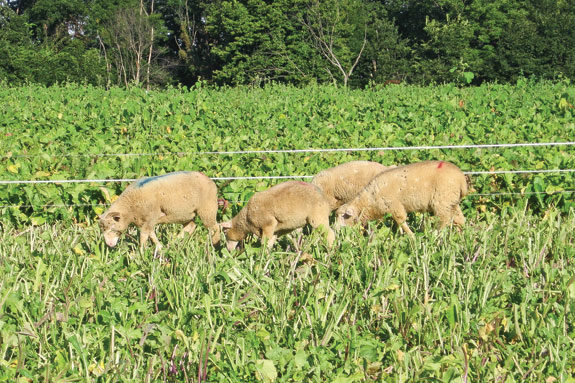Non-traditional forages can provide a large volume of high-quality feed when cool-season forages are not producing during specific times of the year.
Utilizing non-traditional forages takes forethought and planning. Most need to be planted months before they are needed, using equipment the grazier may not have.
Some producers have tried a non-traditional forage and had trouble getting it established. Production suffered, and they become discouraged about the usefulness of the forage in their system.
How will you incorporate an annual into your existing system? Some graziers have successfully included an annual as part of their perennial pasture renovation.
By planting an annual for two years, they can successfully eradicate the existing forages while still harvesting feed from that field.
Others have devoted the most appropriate fields to a rotation of annuals. Summer annuals and winter annuals can be grown on the same field in succession. Basically this double-cropping takes more planning.
Finally, how do you plan to use the annual crop planted? What happens if you have too much or it matures at the same time? Can you harvest it effectively? Will you just graze it? Perhaps you want to use the annual in a combination of production systems, i.e., hay and graze.
Small grains
Most grain crops can also be used for forage. This includes small grains such as wheat, rye, barley, triticale and spring oats.
Planting these in the fall allows for some fall grazing and early-spring grazing. The most widely used are rye and spring oats.
Grazing of small grains should begin when there is enough growth to support livestock. Typically, the two biggest problems are delayed planting dates and wet fields during the prime grazing season.
Begin grazing when at least six inches of growth is available, and leave a two-inch to three-inch stubble after grazing.
Heavy fall grazing increases the risk of winter kill. In the spring, graze only when fields are firm. Heavy or late-spring grazing greatly reduces grain yields.
If you want grain, then remove livestock when the plants begin stem elongation or “jointing” stage.
Summer-annual grasses
These annuals grow rapidly in late spring and summer. This group includes sudan, sorghum-sudan and millet. They can supplement pasture forages when perennial cool-season forages are in the summer slump.
These summer annuals should be grazed after they are 18 inches tall. Grazing earlier will weaken them, causing slower regrowth.
Trampling and wastage will increase when grazing is delayed past the boot stage. Plants reach the grazeable height of 18 to 30 inches about six to eight weeks after planting.
Rotational-grazing or strip-grazing management should be practiced. A high stocking density should be used to graze the grass down in less than 10 days.
Clipping leftover stems down to eight inches will improve forage quality for the next grazing period.
Corn
Corn is a summer-annual grass, but it has a few more options for utilization than the preceding ones. As an annual, it is extremely flexible as to when it can be grazed.
It has been successfully used during the summer, fall and even winter. With the potential to produce more than 10 tons of forage to the acre, few annual crops can compare to corn in terms of dry matter (DM) yield per acre.
Standing corn has the nutritive composition to meet the requirements for many categories of livestock. From the animal’s nutritional standpoint, grazing immature corn is similar to grazing other summer-annual forages.
The big difference comes when the plant reaches maturity. With corn, the loss in the feed value of the forage (leaves and stalk) is compensated by the grain produced.
Corn can be grazed during that midsummer slump that occurs when the temperatures are hot and moisture is short.
Some producers have had success grazing sheep when corn plants are 18 inches tall, rotating quickly so as to protect the growing point (3 to 4 inches above the ground) and rotating back into the corn throughout the summer.
Harvesting corn by grazing may take place from 30 to 100 or more days following planting. Traditionally, producers have planted grazing corn as they would for corn silage, planting corn in late May or early June and grazing it 70 to 90 days following planting.
This late-summer-to-early- fall grazing allows them to stockpile their perennial pastures for late fall or early winter grazing.
Corn may also be grazed extremely late in the season, even after it is fully mature, providing needed energy and shelter during the winter months.
Typically, the corn plant loses some leaves and stalks begin to break down as the winter progresses. This causes a loss in digestible nutrients and protein.
However, the remaining stalks, leaves and grain are still excellent supplemental feed for over-wintering beef cows, stockers and growing animals. Depending on the type of livestock used, producers may have to supplement to compensate for lower protein levels.
Brassicas
Forage brassicas are high-quality, high-yielding, fast-growing crops. Both the tops and bulbs can be grazed.
Brassicas can be planted in April through May for summer grazing or in July through August for fall and winter grazing. All members of the brassica family – turnips, rape, kale and swedes – can be used.
Turnips and rutabagas are short-season root brassicas that provide roots, stem and leaf growth for rotational grazing or strip grazing 70 to 90 days after planting.
Rape is a short-season leafy brassica whose stems and leaves are ready to graze in 90 to 120 days. Kale has highest yields of all brassicas (12,000 pounds per acre dry matter) but requires the longest growing season to produce that (150 days). It has the greatest cold tolerance in the brassica family, surviving temperatures down to 10 degrees.
Brassicas are very high in crude protein and energy but extremely low in fiber. Consider them a concentrate that needs roughage supplementation.
Feeding grass hay or allowing access to grass pastures is usually all that is required. Most dairymen have avoided off-flavors in milk by preventing brassica consumption two hours before milking.
Chicory
Forage chicory is a perennial plant that produces leafy growth. It is higher in nutritive and mineral content than cool-season grasses. It has a deep taproot which helps it produce during drought conditions.
In stands it lasts from two to seven years. Care must be taken to prevent overgrazing. A stubble height of 1.5 to two inches should remain after grazing.
Rotational grazing management is needed for forage chicory persistence. Generally, 25 to 30 days of rest between grazing events is recommended.
Warm-season grasses
Perennial warm-season grasses have potential to produce good hay and pasture growth during the warm and dry midsummer months. Warm-season grasses are slow to establish.
They are weak competitors with weeds and cool-season grasses until established. Two years is generally required for successful establishment of warm-season grasses.
Once established, these grasses should be harvested or grazed when they are 16 to 20 inches or more in height (boot stage).
Once seedheads emerge, quality decreases rapidly. Heading will occur in late June to early July depending on location, year and species.
Mowing or grazing height is critical to stand maintenance. Leave at least a five-inch stubble for rapid regrowth.
Mowing or grazing closer than five inches will remove important plant carbohydrate storage organs and areas of new bud development.
Enough time should be allowed for at least 12 inches of fall regrowth before frost on all species. This means these grasses should not be grazed or harvested after mid-September. Plants can be harvested after a killing frost without damage to the stand and the forage is safe to livestock. FG
References omitted due to space but are available upon request.
—Excerpts from the 10th Heart of America Grazing Conference and 11th Kentucky Grazing Conference Proceedings
PHOTO:
Top: Grazing non-traditional forages Photo courtesy of Jeff McCutcheon.











